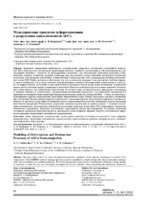Моделирование процессов деформирования и разрушения нанокомпозитов Al/Cu

Date
2022Publisher
Another Title
Modeling of Deformation and Destruction Processes of Al/Cu Nanocomposites
Bibliographic entry
Вахрушев, А. В. Моделирование процессов деформирования и разрушения нанокомпозитов Al/Cu = Modeling of Deformation and Destruction Processes of Al/Cu Nanocomposites / А. В. Вахрушев, А. Ю. Федотов, А. Т. Леконцев // Наука и техника. – 2022. – № 1. – С. 12-18.
Abstract
Проведено молекулярно-динамическое моделирование одноосного растяжения охлажденной композиции Al/Cu. При расчетах использовали программный комплекс LAMMPS, включающий в себя классический код молекулярной динамики с акцентом на моделирование материалов. Для визуализации применяли программу Ovito, имеющую большое количество функций, благодаря чему пользователь может тщательно исследовать полученные результаты. При описании межатомного взаимодействия в нанокомпозите Al/Cu использовали потенциал погруженного атома EAM. Выбор потенциала обусловлен тем, что он адекватно описывает и воспроизводит свойства широкого класса материалов, в том числе металлов, полупроводников и сплавов. Моделирование осуществлялось в два этапа. На первом образец, состоящий из двух кристаллитов алюминия и меди в форме параллелепипедов, соединенных вдоль одной из сводных границ, размещался в расчетной области и охлаждался при постоянном давлении. Охлаждение осуществлялось для стабилизации наносистемы. На втором этапе, соответствующем деформации, температура и давление менялись в соответствии с протекающими физическими процессами. Для управления температурой и давлением на начальной стадии охлаждения использовали алгоритм термостата и баростата Нозе – Гувера. В статье продемонстрирован характер распределения продольных напряжений по всему объему кристалла в процессе растяжения. При достижении образцом предела упругости наблюдались зарождение дефектов кристаллической решетки и распространение их по кристаллу в виде сдвигов и поворотов атомов в кристаллических плоскостях. Определены области зарождения пластических деформаций. Максимальное разрушение материала происходило по границе раздела. С помощью молекулярно-динамического моделирования динамически исследованы параметры композиции Al/Cu (деформация, температура, механическое напряжение). Проведено сопоставление характеристик образца при деформации. В условиях нагружения в материале реализуется множество процессов, включающих в себя генерацию дефектов, упругую и пластическую деформации, генерацию повреждений и механическое перемешивание.
Abstract in another language
The aim of this work is to carry out molecular dynamics simulation of the uniaxial stretching of a cooled Al/Cu composition. The LAMMPS software package has been used for calculations, which includes the classic molecular dynamics code with an emphasis on modeling materials. The Ovito program has been used for visualization, which has a large number of functions, so that the user can thoroughly investigate the results obtained. When describing the interatomic interaction in the Al/Cu nanocomposite, we used the potential of the embedded EAM atom. The choice of potential is due to the fact that it adequately describes and reproduces the properties of a wide class of materials, including metals, semiconductors and alloys. The simulation has been carried out in two stages. At the first stage, a sample consisting of two crystallites of aluminum and copper in the form of parallelepipeds, connected along one of the joint boundaries, was placed in the computational domain and cooled at constant pressure. Cooling was carried out to stabilize the nanosystem. At the second stage, corresponding to the deformation, the temperature and pressure were changed in accordance with the ongoing physical processes. The algorithm of the thermostat and the Nose – Hoover barostat has been used to control the temperature and pressure at the initial stage of cooling. The paper demonstrates the nature of the distribution of longitudinal stresses over the entire volume of the crystal in the process of stretching. When the sample reached the elastic limit, the nucleation of crystal lattice defects and their distribution over the crystal in the form of shifts and rotations of atoms in crystal planes were observed. Areas of plastic deformation origin have been determined. The maximum destruction of the material occurred along the interface. The parameters of the Al/Cu composition (deformation, temperature, mechanical stress) have been dynamically investigated using molecular dynamics simulation. Comparison of the characteristics of the sample in the deformation process has been carried. Under loading conditions, a variety of processes are implemented in the material, including generation of defects, elastic and plastic deformation, generation of damage, and mechanical mixing.
View/
Collections
- № 1[11]
